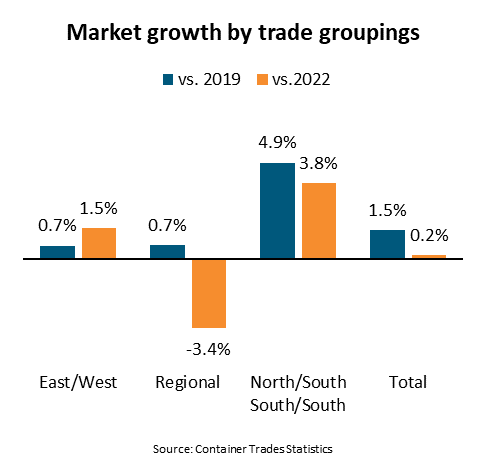In this week’s “Shipping Number of the Week” from BIMCO, Chief Shipping Analyst, Niels Rasmussen, examines the state of the container market in 2023 which has lagged overall economic development significantly in terms of growth. In addition, the fleet capacity continues to swell, challenging liner operators.
According to Niels Rasmussen, in 2023, the container market grew 0.2% year-on-year, ending at 173.8 million TEU. Compared to 2019, before the COVID pandemic hit, the market grew 1.5%. Container market growth has lagged behind overall economic development significantly, as the world economy has grown 10% since 2019.
Highlighting the challenge for liner operators, the container fleet capacity in 2023 grew 21% vs 2019 and 8% vs 2022. The order book of new ships will add nearly 25% to the capacity during the next four and a half years. Although recycling of older ships will moderate the future capacity, fleet growth will be significant.
Initially, the container market saw a strong rebound from the COVID crisis. Container Trades Statistics (CTS) estimates that in 2021 the market was 3.9% larger than in 2023 but has since lost nearly 7 million TEU due to a contraction in both east/west and regional trades.
..says Rasmussen.
Trades within regions, so-called regional trades, contribute about a third of global volumes and have long been key growth drivers for the market. However, CTS estimates that combined volumes in the trade lanes fell 3.7% in 2023 to end only 0.7% higher than in 2019.
The trade within the Europe/Mediterranean region has been the biggest disappointment. Volumes are estimated to have fallen 7.9% in 2023 to end 12.6% lower than in 2019. The reduction in trade between the EU and Russia since the war in Ukraine began has been a significant contributor.
North/south and south/south trades that encompass all trades to and from the South and Central America, Sub-Saharan Africa, and Oceania regions have seen the highest growth rates in the meantime. The trades into Sub-Saharan Africa and the South and Central America regions have stood out with growth rates of respectively 1.1% and 11.8% versus 2022 and 6.8% and 9.1% versus 2019. Exports from East and Southeast Asia have been the key driver.
Growth in the east/west trades between the Asia, Europe/Mediterranean, and North America regions has been hurt by a 12.0% contraction in back-haul trade lanes since 2019 whereas head-haul trades have grown 7.2% since then.
Driven by the development in the Europe and Mediterranean and North America regions, the east/west head-haul trades account for nearly 60% of ship demand. The International Monetary Fund estimates that average annual growth into the two regions will be less than 2% during 2024-2025, adding to concerns about the future supply/demand balance.
..says Rasmussen.
































































